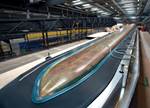Wind economics by the numbers
The upsurge in wind-energy growth is surprising only to those who cannot look at the industry in its wider economic context.
The upsurge in wind-energy growth is surprising only to those who cannot look at the industry in its wider economic context. During the past five years, the price of electricity from fossil fuels (oil, natural gas and coal) increased from $1.54/million Btu in 2005 to $2.22/million Btu as of January 2010. It was within this window that the price of oil also rode its roller coaster from about $50/barrel in 2005, to $140/barrel in mid-2008, down to about $75/barrel as of this writing, (the drop largely the result of a recession-inspired reduction in oil consumption). This net $25/barrel cost increase, combined with the uncertainty bred by oil’s volatility, reduced the relative cost of wind energy and made it a more viable source of electricity. On top of that, the U.S. government’s annually renewable production tax credit (PTC) for manufacturers of renewable energy systems — including wind turbine makers — has been the impetus for much of wind energy’s growth in the U.S. over the last several years. In 2009, Congress renewed the PTC for a multiple-year run, removing the uncertainties during previous years, while developers awaited a renewal decision. This provides a 2.1¢/kWh benefit for the first 10 years of a renewable-energy facility’s operation. All of these factors combined to give birth to the earnest appeal of — and, ultimately, the Obama Administration’s official U.S. stamp of approval on — renewable-energy resources.
It wasn’t always so. During the time periods that predated the volatility of fossil fuel prices, wind energy in the U.S. was a cottage industry — it was relatively small and growing steadily, but not cost-competitive with oil, gas or coal. The number of wind turbines manufactured and installed in the U.S. was modest, yet was showing steady growth: In 1999, installed wind-energy capacity was 2,472 MW. By 2005, it was 9,147 MW. Then, the U.S. climbed aboard the energy roller coaster for a lengthy ride. The result was a series of dramatic increases in U.S. installed wind-energy capacity: 11,575 MW, 16,907 MW, 25,410 MW and 34,863 MW, during the years 2006 through 2009, respectively.
Related Content
-
Composites end markets: Batteries and fuel cells (2024)
As the number of battery and fuel cell electric vehicles (EVs) grows, so do the opportunities for composites in battery enclosures and components for fuel cells.
-
Recycling end-of-life composite parts: New methods, markets
From infrastructure solutions to consumer products, Polish recycler Anmet and Netherlands-based researchers are developing new methods for repurposing wind turbine blades and other composite parts.
-
Achieving composites innovation through collaboration
Stephen Heinz, vice president of R&I for Syensqo delivered an inspirational keynote at SAMPE 2024, highlighting the significant role of composite materials in emerging technologies and encouraging broader collaboration within the manufacturing community.






.jpg;maxWidth=300;quality=90)






